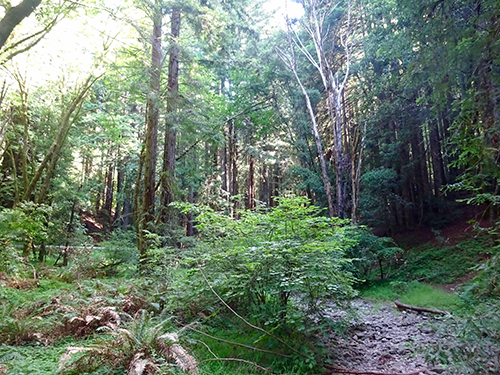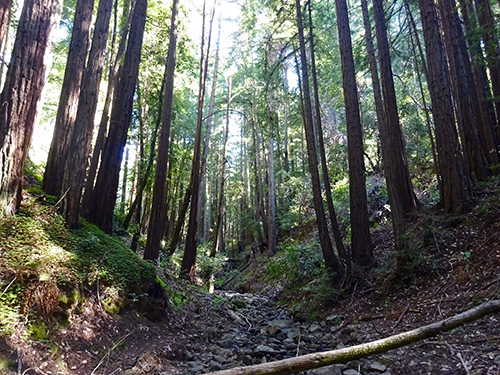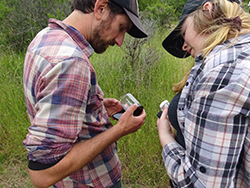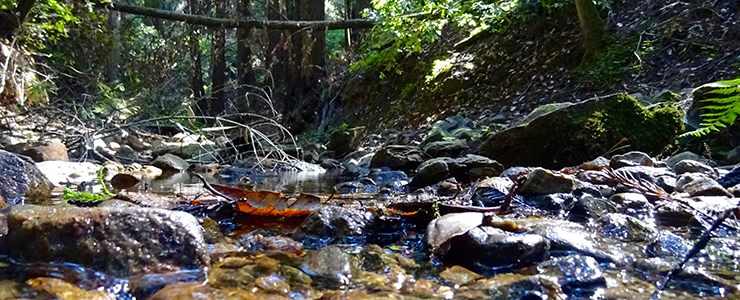Cave Gulch/Wilder
Cave Gulch/Wilder (102 acres)
General Description: Longer and deeper than the Moore Creek drainage, Cave Gulch forms the campus’s largest riparian corridor (Dashe 1982), carries the largest year-round stream found on campus (Stanley 1982), and supports one of the campus’s most mature and protected forests (Cahn et al. 1973). Cave Gulch also connects the lower portion of the campus reserve with the chaparral and mixed evergreen forest of lands on the upper campus. Cave Gulch is also a location that features the campus’s karst topography, a type of topography that forms in areas underlain by marble or limestone. Karst is rare in the western U.S., but the many sinkholes, swallow holes, and caves on the UCSC campus offer ample opportunity for the study of this formation.
 Portions of two stream courses that feed into Meder Creek lie across Empire Grade to the west and are also included in this westernmost portion of the reserve. This area covers a narrow ~850 m N/S strip of redwood and mixed evergreen forest ranging from 80-120 m in width northwest of the main Cave Gulch drainage.
Portions of two stream courses that feed into Meder Creek lie across Empire Grade to the west and are also included in this westernmost portion of the reserve. This area covers a narrow ~850 m N/S strip of redwood and mixed evergreen forest ranging from 80-120 m in width northwest of the main Cave Gulch drainage.
Other significant features of Cave Gulch include the remains of a gold mining operation, located near West Loop Road. As noted in Weiner and Norris (1983), reminders of the mining activity include several tunnels, and old dam, and the foundation of a steam-powered mill.
This area also features a portion of Porter Meadow and a unique California bay and live oak dominated area on the slopes northeast of Family Student Housing.
Geology: Schist forms the basement assemblage in the upper stretch of Cave Gulch; further south, marble forms the basement complex. The “arm” of the reserve that branches off of Cave Gulch along the campus boundary is underlain by Ben Lomond quartz diorite (Stanley 1982).
Within Cave Gulch are many of the reserve’s most interesting geologic features. The caves themselves are an important and unusual resource. According to W.R. Halliday (1956, 1962), who mapped and described some of the caves in detail, caves are infrequent in the Coast Ranges of the western U.S. Empire Cave, the only cave entirely on University property, exhibits a clear fault line and sheetlike deposits of flowstones (Stanley 1982). Extensive human use of Empire Cave since the 1950s have resulted in the destruction of most cave features (CITATION). Bob Curry states that soil samples from caves can be used to tell the climactic history of an area (Curry interview in Weiner and Norris 1983).
Noting other geologic values within the Cave Gulch ravine, Dr. Richard Stanley writes,
“The outcrops in Cave Gulch and in the upper and lower quarries provide the very best glimpses of bedrock geology beneath the cover of vegetation, soils, and construction. In Cave Gulch are the freshest outcrops of schist, migmatite, and various granitoids; many details of mineralogy, texture, and small-scale structures are visible and should be interesting to both students and researchers” (Stanley, personal communication 1986).
Migmatite, the least common rock type on campus, can be found in the stream gravels in the bottom of Cave Gulch, as can rounded, polished cobbles of Ben Lomond quartz diorite (Stanley 1983).
Sheridan rocky sandy loam is the predominate soil type on the steep slopes in the upper section of Cave Gulch; some Felton rocky loam and Holland sandy loam also occur there. Calera rocky clay loam occurs just above Empire Grade, and Calera clay loam occurs adjacent to Empire Grade. Both of these soil types are fairly unusual, covering only six and ten acres of campus, respectively (Arkley 1963). Even more unusual is a deposit of Calera clay, which occurs just north of Family Student Housing—only 2 acres of this soil type occur on campus. Calera clay is derived from limestone, and its formation is a slow, fragile process (Cahn et al. 1973). The influence of this soil on plant growth has received little study, and is thus a potential research topic. According to Twiss (1966), all of the Calera soils, which develop only on limestone and marble bedrock, are unusual on the west coast. Because they are mined by cement operators, these soils are becoming increasingly rare.
 Plants: The botanical resources of Cave Gulch vary considerably from those of Moore Creek. Deeper and shadier than Moore Creek, many parts of Cave Gulch are heavily wooded. Redwoods predominate, and in places little grows on the forest floor except redwood sorrel (Oxalis oregano). More open areas support a varied understory, including madrone, western azalea (Rhododendron occidentale), tanoak (Notholithocarpus densiflorus), and coffeeberry (Frangula californica). The campus’s largest Douglas-firs (Pseudotsuga menziesii)—some almost two hundred feet tall—occur in Cave Gulch.
Plants: The botanical resources of Cave Gulch vary considerably from those of Moore Creek. Deeper and shadier than Moore Creek, many parts of Cave Gulch are heavily wooded. Redwoods predominate, and in places little grows on the forest floor except redwood sorrel (Oxalis oregano). More open areas support a varied understory, including madrone, western azalea (Rhododendron occidentale), tanoak (Notholithocarpus densiflorus), and coffeeberry (Frangula californica). The campus’s largest Douglas-firs (Pseudotsuga menziesii)—some almost two hundred feet tall—occur in Cave Gulch.
According to Dash (1982), Cave Creek supports the largest fern population on campus. Significant fern species that occur in the gulch include Dudley’s shield fern (Polystichum dudleyi), California shield fern (P. californicum), deer fern (Blechnum spicant), and licorice fern (Polypodium glycyrrihiza). According to biology professor Dr. William Doyle, deer fern reaches its southern range limit in Cave Gulch (interview in Weiner and Norris 1983). California fetid adder’s tongue (Scoliopus bigelovi) and Alaska oniongrass (Melica subulata) also reach their southern limits in the Cave Gulch area (Stone 1983).
Porter Meadow features occasionally dense stands of sky lupine (Lupinus nanus) and a population of yellow mariposa lily (Calochortus luteus), uncommon in Santa Cruz County.
Animals: Cave Gulch provides an important faunal as well as floral habitat. Like the other campus riparian corridors, it serves as a living and transportation area for predators (coyotes, raptors, etc.) (Margaret Fusari, interview in Weiner and Norris 1983). Shrews, moles, and shrew-moles inhabit the deep redwood forest, and Pacific wrens are restricted to the deep ravines (Luckenbach 1983). A red-tailed hawk nest was found high in the trees in Cave Gulch in 1976 (Cahn et al. 1976), and Luckenbach (1983) also maps two raptor nest sites as occurring there. Pileated woodpeckers have been reported from campus and may be year-round residents of Cave Gulch (Cahn et al. 1976). Another significant vertebrate, the California giant salamander (Dicamptodon ensatus) also occurs in Cave Gulch. This is the largest land salamander in the world, growing to almost a foot in length (including the tail). According to Stebbins (1985), Santa Cruz County is the southern range limit for this species. It is possible that some of the paedomorphic D. ensatus found within Cave Gulch, and in Empire Cave itself, may actually be a distinct species (B. Sinervo, pers.comm.; LRDP 2005).
The caves of the gulch create another faunal habitat. R.E. Graham (1976) writes, “Empire Grade contains one of the most important crepusculate faunas in the Central Coast Ranges…” Four species of invertebrates from Empire Cave are considered federal species of special concern: the Santa Cruz Telemid spider (Telemid sp.); Meta dolloff, a spider in the Araneidae family; Stygobromus mackenziei, an amphipod; and Fissilicreagris imperialis, a pseudoscorpion (LRDP 2005). Six species of cave invertebrates are thought to be endemic to the Cave Gulch drainage (Ubick 2001).
Management: Current management includes invasive species management and signage attempting to reduce impacts to Empire Cave. See below for stewardship management opportunities.
 Opportunities for teaching, research, and stewardship: CNR areas around Family Student Housing, Porter Meadow, and the section of Cave Gulch near Empire Cave are readily accessible for course field trips. Having groups meet at the Porter Squiggle (the red metal sculpture on the hill above the Porter/College 8
Opportunities for teaching, research, and stewardship: CNR areas around Family Student Housing, Porter Meadow, and the section of Cave Gulch near Empire Cave are readily accessible for course field trips. Having groups meet at the Porter Squiggle (the red metal sculpture on the hill above the Porter/College 8
bus stop) allows for easy and quick access to these reserve areas. Karst geology, cavernicolous fauna, California giant salamanders, Sudden Oak Death, grasslands, forest intrusion, and redwood forest are all rich topics for study. These topics could be investigated by researchers as well. Stewardship opportunities include cave and meadow clean-ups, trail maintenance, erosion control, removal of coyote brush and tree saplings to slow forest intrusion, mowing and/or grazing of meadow areas (no fencing currently exists, however).

